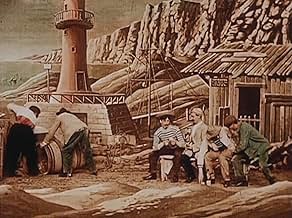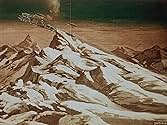NOTE IMDb
7,5/10
4,3 k
MA NOTE
Ajouter une intrigue dans votre langueUsing every known means of transportation, several savants from the Geographic Society undertake a journey through the Alps to the Sun which finishes under the sea.Using every known means of transportation, several savants from the Geographic Society undertake a journey through the Alps to the Sun which finishes under the sea.Using every known means of transportation, several savants from the Geographic Society undertake a journey through the Alps to the Sun which finishes under the sea.
- Réalisation
- Scénario
- Casting principal
Fernande Albany
- Madame Latrouille
- (non crédité)
Jehanne d'Alcy
- Villager at seaport
- (non crédité)
May de Lavergne
- Nurse in Swiss hospital
- (non crédité)
Avis à la une
Having produced a blockbuster in 1903 in which a group of scientists journeyed to the moon, Melies tried to outdo himself the following year by having another group of manic scientists travel to the sun. He made this film longer and stencilled it in colour, and the outcome is quite astounding. To think that Melies was producing lengthy masterpieces like this while contemporary filmmakers were still experimenting with one-shot narratives goes to show how far ahead of his time Melies really was - which makes his downfall less than a decade later all the sadder. Melies fills the screen with colour with sets sometimes similar to the expressionist sets of the German masterpieces of the late teens and 20s, and fills it also with movement. Not one moment passes when there isn't something to look at. Although this film is not as widely known as Le Voyage dans la lune for my money it surpasses it in terms of exuberance and imagination.
I suppose you could consider this film as a spiritual follow up to A Trip to the Moon. The latter remains George Méliès most famous and iconic film; probably for good reason considering its ambition and imagination. An Impossible Voyage explores similar territory and is certainly a worthy companion-piece as an example of early cinematic science fiction.
In this one a group of scientists don't go to the moon, they head further afield to the sun. Perhaps this illustrates Méliès reaching out further too. Certainly this is another example of him developing the idea of what cinema could be. Unlike most of his peers, he was taking the medium into the story-telling sphere. Films like this were in this sense the beginnings of modern cinema as we know it.
The film features a nice colour tint that adds a great deal to the fantastical look. It contains a number of hand painted sets that gives it all a highly stylised look. The scientists' adventure not only takes them to the sun but also across the mountains of Switzerland, which Méliès also depicts like an alien landscape. The travellers end up in the bottom of the ocean completing their amazing journey. All in all this is an entertaining and highly imaginative work, well worth catching.
In this one a group of scientists don't go to the moon, they head further afield to the sun. Perhaps this illustrates Méliès reaching out further too. Certainly this is another example of him developing the idea of what cinema could be. Unlike most of his peers, he was taking the medium into the story-telling sphere. Films like this were in this sense the beginnings of modern cinema as we know it.
The film features a nice colour tint that adds a great deal to the fantastical look. It contains a number of hand painted sets that gives it all a highly stylised look. The scientists' adventure not only takes them to the sun but also across the mountains of Switzerland, which Méliès also depicts like an alien landscape. The travellers end up in the bottom of the ocean completing their amazing journey. All in all this is an entertaining and highly imaginative work, well worth catching.
Director Georges Méliès was an absolutely brilliant early filmmaker and innovator. His camera tricks, use of a complex plot and sets, and fun-loving fantasy elements in his films made him the greatest film maker of his day. While I recently read that THE GREAT TRAIN ROBBERY (from Edison Inc.) was the "first full-length film", this simply isn't true, as Méliès' LE VOYAGE DANS LE LUNE (1902) preceded it and was a much more complex film--featuring amazing sets and lots of laughs as a group of scientists take a trip to the moon and meet the evil moon men! Only a year later, in an attempt to outdo his previous success, Méliès made this film about another group of wacky scientists who take a trip to the Sun as well as under the sea!! And, while the original film was a very long 14 minutes (that WAS full-length in its day), this one is 20--making it probably the longest film of its day.
While the new film is obviously strongly derived from the previous Méliès epic, compared to all other films of the day it is still brilliant and not even close to being matched. BUT, my score of 9 is more a way to indicate that it isn't quite as good as his film about the Moon. But, it is still very, very watchable and cute even today (something that can't be said of most other films of the age).
If you want to see this film online, go to Google and type in "Méliès" and then click the video button for a long list of his films that are viewable without special software.
While the new film is obviously strongly derived from the previous Méliès epic, compared to all other films of the day it is still brilliant and not even close to being matched. BUT, my score of 9 is more a way to indicate that it isn't quite as good as his film about the Moon. But, it is still very, very watchable and cute even today (something that can't be said of most other films of the age).
If you want to see this film online, go to Google and type in "Méliès" and then click the video button for a long list of his films that are viewable without special software.
really a great hand colored early science fiction movie with full of early special effects,greatest moment in the film that they reach the sun and go into the suns mouth with a train,this scene is very familiar with the trip to the moon when they reach the moon. The tour through the swiss landscape is also a great moment.
Anybody who's seen Melies' "A Trip to the Moon" should certainly watch this. It not only surpasses the run time of the earlier film, (resulting in a 20 minute production which was amazing for its time), it is visually astounding and fantastic. Even though Melies had already indulged in multi-scene spectacles by this time, this was without a doubt the "Intolerance" of its day. Visual effects, nice color, beautiful sets...wow.
Many people have been calling this a sequel to "A Trip to the Moon" and I can see why they're saying that, because it is yet again a sci-fi topic. Instead of the moon, however, the scientists here go to the sun. There's tons of build-up too. First, they have to build the means of transportation (a train). Then, they go on this huge journey through the Swiss landscape. Then, their car gets busted and they have to spend days in the hospital. Obviously, Melies was more or less padding it out with all this build-up, but with all the action and detail put into each scene, there is plenty to see.
Melies obviously had an imagination. Not only had anybody ever gone to the moon by 1902, ANY sort of space travel was unheard of. Thus, even now we realize how utterly impossible it is to go to the sun (through the mouth, no less). But Melies was all about creating the impossible. This movie is such a visual treat that even people today could be entertained.
Also, it can be noted a supplemental section to this was made, where Crazyloff manages to recover the equipment lost in the sun by using a gigantic magnet to pull it all back to earth. It is unknown whether this section has survived, as John Frazer claims to have once inspected a print, while Malthete lists the short as lost.
Many people have been calling this a sequel to "A Trip to the Moon" and I can see why they're saying that, because it is yet again a sci-fi topic. Instead of the moon, however, the scientists here go to the sun. There's tons of build-up too. First, they have to build the means of transportation (a train). Then, they go on this huge journey through the Swiss landscape. Then, their car gets busted and they have to spend days in the hospital. Obviously, Melies was more or less padding it out with all this build-up, but with all the action and detail put into each scene, there is plenty to see.
Melies obviously had an imagination. Not only had anybody ever gone to the moon by 1902, ANY sort of space travel was unheard of. Thus, even now we realize how utterly impossible it is to go to the sun (through the mouth, no less). But Melies was all about creating the impossible. This movie is such a visual treat that even people today could be entertained.
Also, it can be noted a supplemental section to this was made, where Crazyloff manages to recover the equipment lost in the sun by using a gigantic magnet to pull it all back to earth. It is unknown whether this section has survived, as John Frazer claims to have once inspected a print, while Malthete lists the short as lost.
Le saviez-vous
- AnecdotesIncluded in the "Georges Melies: First Wizard of Cinema (1896-1913)" DVD collection, released by Flicker Alley.
- GaffesFor a few seconds, a pole can clearly be seen holding the anthropomorphic sun up.
- Versions alternativesAlso available in a computer colorized version.
- ConnexionsFeatured in Karl May, à la recherche du paradis perdu (1974)
Meilleurs choix
Connectez-vous pour évaluer et suivre la liste de favoris afin de recevoir des recommandations personnalisées
Détails
- Date de sortie
- Pays d’origine
- Langues
- Aussi connu sous le nom de
- Voyage à travers l'impossible
- Lieux de tournage
- Sociétés de production
- Voir plus de crédits d'entreprise sur IMDbPro
Box-office
- Budget
- 37 500 F (estimé)
- Durée24 minutes
- Couleur
- Mixage
- Rapport de forme
- 1.33 : 1
Contribuer à cette page
Suggérer une modification ou ajouter du contenu manquant

Lacune principale
By what name was Le voyage à travers l'impossible (1904) officially released in India in English?
Répondre




















